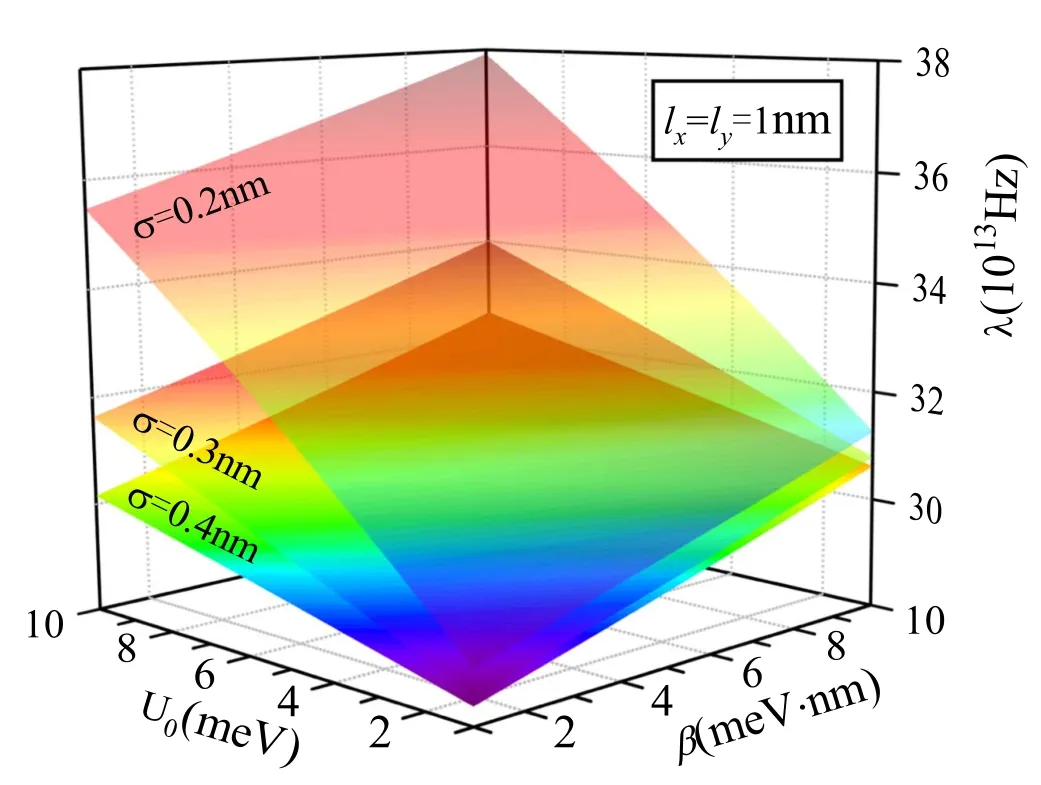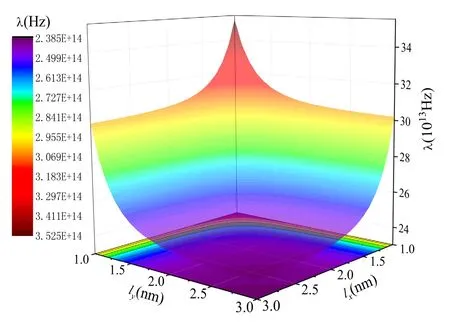Effects of an anisotropic parabolic potential and Coulomb’s impurity potential on the energy characteristics of asymmetrical semi-exponential CsI quantum wells
Institute of Condensed Matter Physics,Inner Mongolia University for Nationalities,Tongliao 028043,China
Abstract Because of its unique optoelectronic properties,people have studied the characteristics of polarons in various quantum well(QW)models.Among them,the asymmetrical semiexponential QW(ASEQW)is a new model for studying the structure of QWs in recent years.It is of great significance to study the influences of the impurity and anisotropic parabolic confinement potential(APCP)on the crystal’s properties,because some of the impurities,usually regarded as Coulomb’s impurity potential(CIP),will exist in the crystal more or less,and the APCP has flexible adjustment parameters.However,the energy characteristics of the ASEQW under the combined actions of impurities and APCP have not been studied,which is the motivation of this paper.Using the linear combination operation and Lee–Low–Pines unitary transformation methods,we investigate the vibrational frequency and the ground state energy of the strong coupling polaron in an ASEQW with the influences of the CIP at the origin of coordinates and APCP,and make a comparison between our results and previous literature’s.Our numerical results about the energy properties in the ASEQW influenced by the CIP and APCP may have important significances for experimental design and device preparation.
Keywords:asymmetrical semi-exponential quantum well,anisotropic parabolic confinement potential,vibrational frequency,Coulomb's impurity potential,ground state energy
1.Introduction
The development and progress of experimental technologies has made the manufactures of various low-dimensional structures possible.Because nano-low-dimensional systems have important scientific research value and their unique photoelectric properties and transport characteristics,they have extremely broad application prospects and potential economic values.Compared with other low-dimensional structures,quantum wells(QWs)have higher quantum efficiency,so they are used to make light-emitting devices and photodetector devices.Due to the broad development prospects of QWs in the field of optoelectronics,the study of polarons in QWs of various structures has made considerable progress[1–6].The optical properties of single QW[7],multiple QW[8]and doped QW[9]were studied respectively.Ungan et al shown the optical properties of QWs under the triple influence of electric field,magnetic field and laser field[10].
Among many types of QWs,the asymmetrical semiexponential QW(ASEQW)is a new model to study the structure and performance of QWs in recent years.Guo Kangxian’s team[11–16]and Wang et al[17]have studied the polaron’s optical properties and the temperature effect of the ground state energy(GSE)in ASEQW,respectively.Impurities are inevitably introduced during the material manufacturing process.Therefore,people had paid attention to the influences of impurities on the properties of crystals for a long time[18,19].Xiao studied the influences of the Coulomb’s impurity potential(CIP)on the energy characteristics[20]and coherent properties[21]in the asymmetric Gaussian confinement QW,and found that the CIP can improve the stability of the AGCPQW system,however,the CIP can seriously damage the coherent properties of the polaron.So far,according to our knowledge,only[22,23]have studied the influences of the CIP and temperature on the ground state binding energy and GSE in the ASEQW.
However,none of the above references considering the properties of the ASEQW under the combined actions of the anisotropic parabolic confinement potential(APCP)and CIP.Inspired by the[10],we consider and investigate the impacts of these factors on the energy level structure of the ASEQW.Numerical calculations are performed on the actual material CsI,and the obtained results are compared with the previous literatures.
2.Theoretical models
The electron interacts with bulk longitudinal optical phonons and moves in the ASEQW influenced by the CIP at the origin of coordinates and APCP.Inspired by the[13,22,24],the Hamiltonian of the system in the ASEQW under the combined actions of the CIP and APCP reads as follows:

where

Giving Fourier expansion to the CIP[25],

For electron–phonon strong coupling,the equation(1)is performed on the second Lee–Low–Pines unitary transformation(LLPUT)[26]and employed by the linear combination operation(LCO)[27]:

The system’s ground state wave function is chosen as

where∣0〉aand∣0〉bsatisfybj∣0〉b=aq∣0〉a=0.
By computations,the strong coupling system’s vibrational frequency(VF)in the ASEQW under the combined actions of the CIP and APCP can be obtained and written as

Assuming the root of equation(8)is λ0,the system’s GSE can be gotten variationally

where lxand lyare the x and y directions effective confinement lengths,respectively.
3.Results and discussion
In order to fully explore the energy characteristics of the polaron in the ASEQW under the combined actions of the CIP and APCP,numerical results about its GSE and the VF have been displayed in figures 1–4.Choosing the CsI crystal,adopted experimental parameters are α=3.67,11.616 meV,m=0.42m0and m0=9.1×10−31kg[28].

Figure 1.The GSE E0 versus the CIPS β and parameter U0.

Figure 2.The VF λ versus the CIPS β and parameter U0.

Figure 3.The GSE E0 versus the x and y directions effective confinement lengths lx and ly.

Figure 4.The VF λ versus the x and y directions effective confinement lengths lx and ly.
Figures 1 and 2 depict the GSE E0and the VF λ of the strong coupling impurity polaron in the CsI ASEQW versus the CIPS and the ASECP’s positive parameter U0when the x and y directions effective confinement lengths satisfy lx=ly=1.0 nm for other three different positive parameters σ=0.2,0.3,0.4 nm.The numerical results of figure 1 indicate that the GSE of the strong coupling impurity polaron in the ASEQW is an enhancing(decreasing)function of the positive parameter U0(σ).The reason is that the main property of the GSE is due to ASECP added in the growth direction of the ASEQW.The ASECP is an elevating(decreasing)function of the parameter U0(σ)seen from the equation(2).Therefore,the GSE of impurity polaron increases(decreases)with increasing the parameter U0(σ).In this figure,We also can observe that the GSE E0is enlarged by decreasing the CIPS β.As can be seen from the expression of the GSE that the last term of the equation(9),which value is negative,representing the contribution of the CIP to the GSE.Therefore,the GSE will decrease with increasing the CIPS.The changing laws obtained here are consistent with the laws in the asymmetric Gaussian confinement QW[20]and the ASEQW[23].Simultaneously,comparing the results of this paper with the conclutions in[20,23],which consider the temperature effects,we indirectly found that the introductions of the CIP will cause the increase of the energy level in the ASEQW,which will destroy the stability of the system and then weaken the luminescence characteristics of devices based on the ASEQW.
The results of figure 2 also imply that the VF λ is an increasing(decreasing)function of the positive parameter U0(σ).This phenomenon is still due to the fact that the confinement of the ASECP becomes strong(weak)with enlarging U0(σ).Thereby,the VF of impurity polaron lifts(reduces)with increasing the positive parameter U0(σ).Furthermore,the figure 2 also reveals that as the CIPS β enlarges,the VF of the impurity polaron increases.The reason is that when the CIPS is applied to a system,an additional energy will be added to the system.It is clear that the presence of the CIPS is equivalent to introduce another new confinement to the system.It will lead to greater electron wavefunction overlapping,then the polaron’s internal interactions will be raised.Therefore,the VF elevates.This numerical result is consistent with[22].
In figures 3 and 4,we respectively plot the GSE E0and the VF λ versus the effective confinement lengths lxand lyfor the ASECP’s two positive parameters and the CIPS satisfy U0=10 meV,σ=0.2 nm and β=0.1 meV·nm.The numerical results in figures 3 and 4 show that the GSE and the VF of the polaron reduces rapidly with elevating the effective confinement lengths.Their changing reasons are same.Because the motion of the electrons is confined by the APCP in the x and y directions.With the deduce of the effective confinement lengths,the electronic thermal motion energy and the polaron’s internal interactions are enlarged rapidly.Therefore,the GSE and the VF are increased.The changing laws are consistent with the laws of the energy level and the VF versus the effective confinement lengths in the quantum dot[29,30],which were influenced by the APCP.It shows that the introduction of the APCP makes the polaron’s characteristics in the ASEQW have a more flexible adjustment methods.
4.Conclusions
Utilizing the LCO and LLPUT methods,this paper theoretically explores the influences of the CIP and APCP’s combined actions on the energy level characteristics of the polaron in the ASEQW.The numerical results show that:①We have found five ways for adjusting the energy level structures of polarons in ASEQW:changing the CIPS,the x and y directions effective confinement lengths of the APCP,and two positive parameters of ASECP;②Not only the introduction of the APCP makes the polaron characteristics in ASEQW more flexible to adjust; but also comparing the results in the previous references,which consider the temperature effects,we indirectly find that the introductions of the CIP will cause the increase of the energy level in the ASEQW,which will damage the stability of the system and the luminescence characteristics of devices based on the ASEQW.
Acknowledgments
This project was supported by the National Natural Science Foundation of China under Grant No.11 464 034,the National Science Foundation of Inner Mongolia Autonomous Region under Grant Nos.2016MS0119 and 2016BS0107,Research Program of Science and Technology at Universities of Inner Mongolia Autonomous Region under Grant No.NJZY16183,and the Scientific Research Fund of Inner Mongolia University for Nationalities under Grant Nos.NMDYB1756 and NMDYB18024.
 Communications in Theoretical Physics2021年1期
Communications in Theoretical Physics2021年1期
- Communications in Theoretical Physics的其它文章
- Edge effect and interface confinement modulated strain distribution and interface adhesion energy in graphene/Si system
- Effects of rebinding rate and asymmetry in unbinding rate on cargo transport by multiple kinesin motors
- Phase transitions of two spin-1/2 Baxter–Wu layers coupled with Ising-type interactions
- Three-dimensional cytoplasmic calcium propagation with boundaries
- Interplay of parallel electric field and trapped electrons in kappa-Maxwellian auroral plasma for EMEC instability
- Hidden periodicity in Stripe 82 with Saraswati supercluster—a fractal analysis
